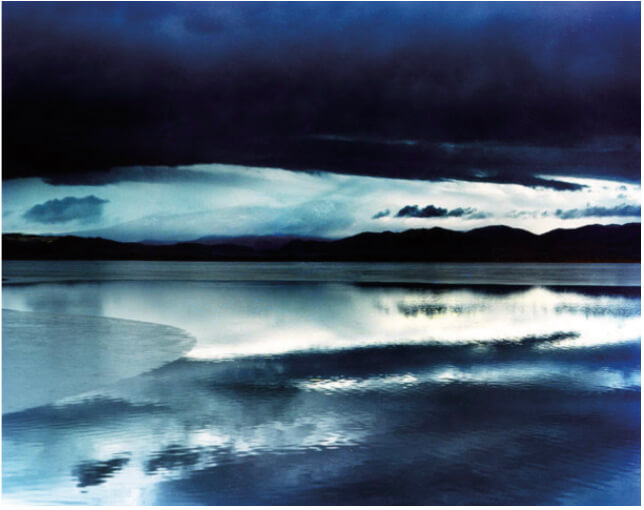
San Francisco art galleries are offering by-appointment viewing of exhibitions originally scheduled to open last spring. Seven Rivers – which was supposed to start accepting visitors in March at Euqinom Gallery on Alabama Street – is an expansive journey in experimental landscape pictures from Idaho photographer Ansley West Rivers.
In 2013, West Rivers set out to examine environmental changes by photographing seven American rivers. Her subsequent travels to the Colorado, Missouri, Mississippi, Columbia, Rio Grande, Tuolumne, Altamaha, and Hudson rivers inspired a secondary component: handmade maps. This exhibition focuses on a selection of photographs of Western American locations and includes two new maps of Bay Area waterways.
West Rivers shoots on a large format camera, often exposing multiple pictures onto a single negative that she later prints digitally 24 by 30 inches. This subtle collaging – what the artist calls “constructed landscapes” – is a traditional landscape photography device. Western American landscape photographer Ansel Adams often printed from multiple negatives to achieve his sublime imagery, perfecting the innovation of French photographer Gustave Le Gray: combination printing. West Rivers’s invention is executing the style in-camera rather than in the darkroom or on Photoshop.

Power Lines, Columbia River, Washington, 2015, is the most obvious example of West Rivers’s technique. One exposure shows the snow-like expanse of water; a second adds a steel tower and a stretch of power lines to the composition. The artist’s trickery might be easy to spot, but that doesn’t lessen the visual impact. The disturbance of process is meant to emphasize technological disruptions of landscape, a pertinent environmental commentary, if sometimes a bit milquetoast in its delivery.
In other double-exposures, West Rivers’s technical experimentation creates a flawless illusion. King Canyon, Rio Grande River, Williamsburg, New Mexico, 2016, is evocative of Adams’s Yosemite pictures. A mountain range hovers over winding waters; the divide between exposures is neatly swathed in shadows, creating an eerie surrealism.
The maps are similarly constructed using multiple exposures: the lines of the map-image are a platinum print; the landmass a Van Dyke; the water itself is poured and brushed cyanotype chemistry, dark blue. Another form of “constructed landscape,” this painterly take on the photographic process – or vivid take on cartography – harmonizes with a water theme and presents the most unique work in the show. North Bay May (Bodega Bay to San Joaquin River), 2020, spans two walls, each panel peeling at the edges with the quality of old parchment. Standing before one of these maps the viewer feels the immensity of the outdoors that the much smaller photographs can’t convey.
Unlike the founders of Western American landscape photography, West Rivers isn’t trying to “lure people out West.” Where she does converge with Adams and other expansionists before him is in the question her work raises: What was here before? These unpeopled landscapes are haunted by the absence of indigenous civilizations that first benefited from the water – in short supply on tribal lands now – just as the landscapes may lose the waterways themselves. The two disappearances are related. American industrialism, one impact of which is climate change, was founded on Westward expansion. The flux of the river is an apt metaphor for adaptability and endurance, until the water evaporates. Then, it’ll be for future photographers to renew the question: What was here before?
Seven Rivers is on-view by appointment at Euqinom Gallery through August 29, 2020.

